Transformation of Chinese Firms into Multinational Corporations
VerifiedAdded on 2023/06/09
|13
|3533
|417
AI Summary
This paper focuses on the transformation of Chinese firms into multinational corporations, discussing the motives behind it, advantages and disadvantages, and the role of government in stimulating foreign direct investment. It also covers the difference between the linkage leverage model and ownership location internalization model. The paper provides insights into the subject of international business and is relevant for students pursuing courses in this field.
Contribute Materials
Your contribution can guide someone’s learning journey. Share your
documents today.

0
Running head: INTERNATIONAL BUSINESS
International business
Name of the student:
Name of the University:
Author note
Running head: INTERNATIONAL BUSINESS
International business
Name of the student:
Name of the University:
Author note
Secure Best Marks with AI Grader
Need help grading? Try our AI Grader for instant feedback on your assignments.

1INTERNATIONAL BUSINESS
Executive summary:
The following paper aims to focus on the transformation of the different firms in the
developing nation towards the multinational corporations. The first part the main motives
behind the transformation of the Chinese firms to MNCs. The part after the motives behind
the transformation states how the Foreign Direct investment helps in transforming the
multinational enterprises of China. Both advantages and disadvantages of the transformation
of firms into MNCs are been discussed. Reasons behind applying linkage leverage model and
ownership location internalization model have been also further stated. Lastly, the role of
government behind stimulating the foreign direct investment in the developing countries has
been described.
Executive summary:
The following paper aims to focus on the transformation of the different firms in the
developing nation towards the multinational corporations. The first part the main motives
behind the transformation of the Chinese firms to MNCs. The part after the motives behind
the transformation states how the Foreign Direct investment helps in transforming the
multinational enterprises of China. Both advantages and disadvantages of the transformation
of firms into MNCs are been discussed. Reasons behind applying linkage leverage model and
ownership location internalization model have been also further stated. Lastly, the role of
government behind stimulating the foreign direct investment in the developing countries has
been described.
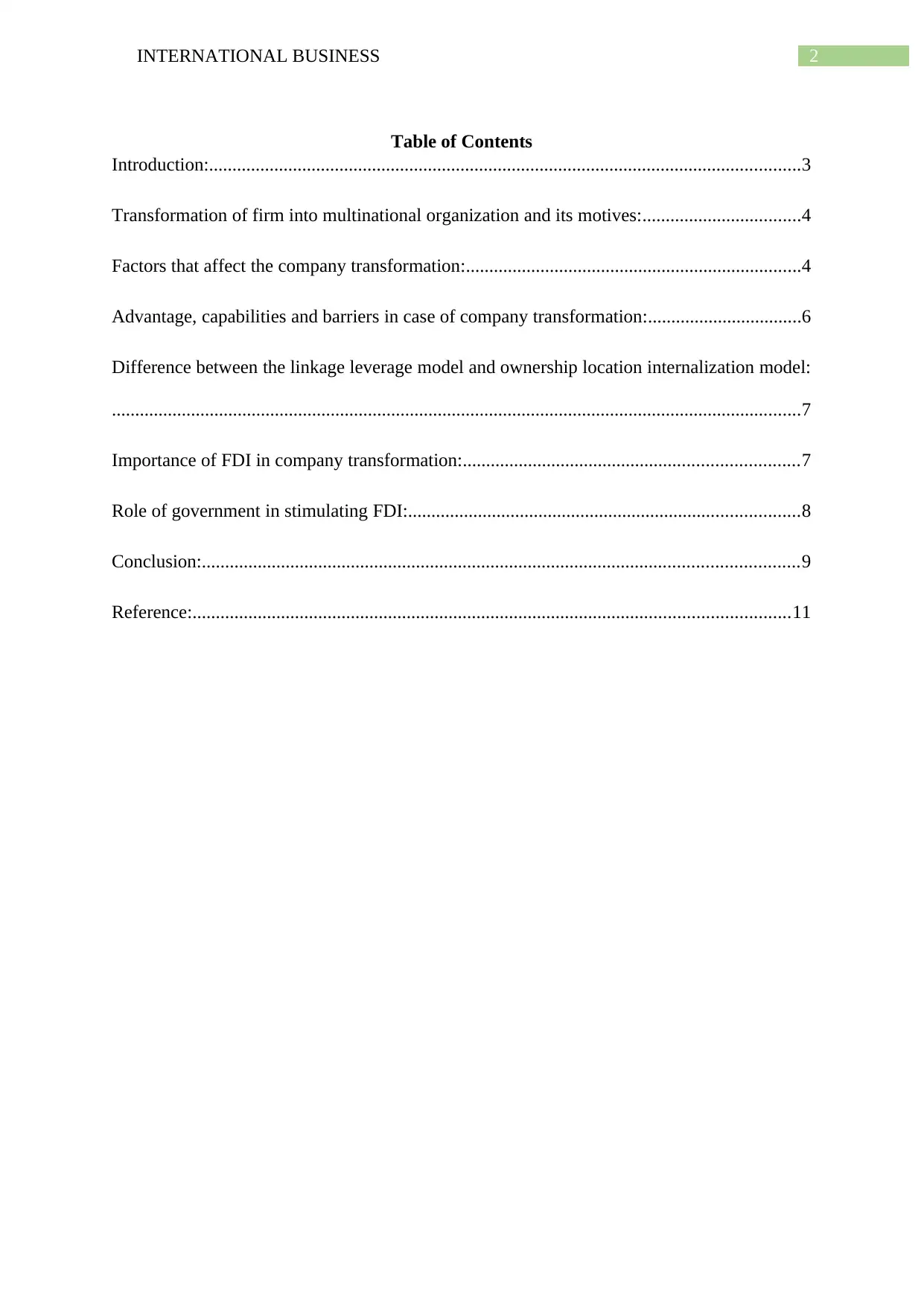
2INTERNATIONAL BUSINESS
Table of Contents
Introduction:...............................................................................................................................3
Transformation of firm into multinational organization and its motives:..................................4
Factors that affect the company transformation:........................................................................4
Advantage, capabilities and barriers in case of company transformation:.................................6
Difference between the linkage leverage model and ownership location internalization model:
....................................................................................................................................................7
Importance of FDI in company transformation:........................................................................7
Role of government in stimulating FDI:....................................................................................8
Conclusion:................................................................................................................................9
Reference:................................................................................................................................11
Table of Contents
Introduction:...............................................................................................................................3
Transformation of firm into multinational organization and its motives:..................................4
Factors that affect the company transformation:........................................................................4
Advantage, capabilities and barriers in case of company transformation:.................................6
Difference between the linkage leverage model and ownership location internalization model:
....................................................................................................................................................7
Importance of FDI in company transformation:........................................................................7
Role of government in stimulating FDI:....................................................................................8
Conclusion:................................................................................................................................9
Reference:................................................................................................................................11

3INTERNATIONAL BUSINESS
Introduction:
One of the important topics used for media interests and academic research which is quite
famous all throughout the world is the globalization of the business firms from the
developing economies. The increase in the flow of outward foreign direct investment (OFDI)
from developing nations like Singapore and Hong Kong and transition economies consisting
of Russia and China is not very surprising (Rugman, Nguyen and Wei 2016). Over the past
thirty years, the mainland China have witnessed a huge economic development along with
transformation which in turn allows many firms from the mainland China to accumulate
enough location specific and firm specific advantages before they go for venturing abroad. In
the recent years, China has joined the newly industrialized economies (NIEs) of Latin
America and Asia in order to produce many competitive transnational corporations (Cherry
2015). The high-profile international acquisitions of the modern age along with the takeover
bids by the Chinese companies have dramatically shifted the attention of media from
stating China as a “giant seeking vacuum cleaner” in the case of global inward foreign direct
investment (FDI) to making the country as a cash-rich predator on a global buying binge. The
firms of China which have listed in Fortune 500 have been the main players in the cross-
border mergers and acquisitions (M & As) of China which has been carried out since the year
2002 (Fan, Cui and Zhu 2016). Some of the examples include the takeover of the Addax
petroleum, which is a Swiss-Canadian Company, and the partial acquisitions of Repsol YPF
Brazil. Other examples include Sync rude Canada by Sinopee, acquisitions of twenty percent
stake of the South African Standard Bank by The Industrial and Commercial Bank of China
(ICBC) (Wang, Wang and Liang 2016). The takeover of Petro Kazakhstan by the China
National Petroleum Corporation (CNPC) is some of the important examples. Under this
scenario, the report ids aimed to analyse the motive, impact and factors that influenced the
cross-border multinational transformation of the firms.
Introduction:
One of the important topics used for media interests and academic research which is quite
famous all throughout the world is the globalization of the business firms from the
developing economies. The increase in the flow of outward foreign direct investment (OFDI)
from developing nations like Singapore and Hong Kong and transition economies consisting
of Russia and China is not very surprising (Rugman, Nguyen and Wei 2016). Over the past
thirty years, the mainland China have witnessed a huge economic development along with
transformation which in turn allows many firms from the mainland China to accumulate
enough location specific and firm specific advantages before they go for venturing abroad. In
the recent years, China has joined the newly industrialized economies (NIEs) of Latin
America and Asia in order to produce many competitive transnational corporations (Cherry
2015). The high-profile international acquisitions of the modern age along with the takeover
bids by the Chinese companies have dramatically shifted the attention of media from
stating China as a “giant seeking vacuum cleaner” in the case of global inward foreign direct
investment (FDI) to making the country as a cash-rich predator on a global buying binge. The
firms of China which have listed in Fortune 500 have been the main players in the cross-
border mergers and acquisitions (M & As) of China which has been carried out since the year
2002 (Fan, Cui and Zhu 2016). Some of the examples include the takeover of the Addax
petroleum, which is a Swiss-Canadian Company, and the partial acquisitions of Repsol YPF
Brazil. Other examples include Sync rude Canada by Sinopee, acquisitions of twenty percent
stake of the South African Standard Bank by The Industrial and Commercial Bank of China
(ICBC) (Wang, Wang and Liang 2016). The takeover of Petro Kazakhstan by the China
National Petroleum Corporation (CNPC) is some of the important examples. Under this
scenario, the report ids aimed to analyse the motive, impact and factors that influenced the
cross-border multinational transformation of the firms.
Secure Best Marks with AI Grader
Need help grading? Try our AI Grader for instant feedback on your assignments.
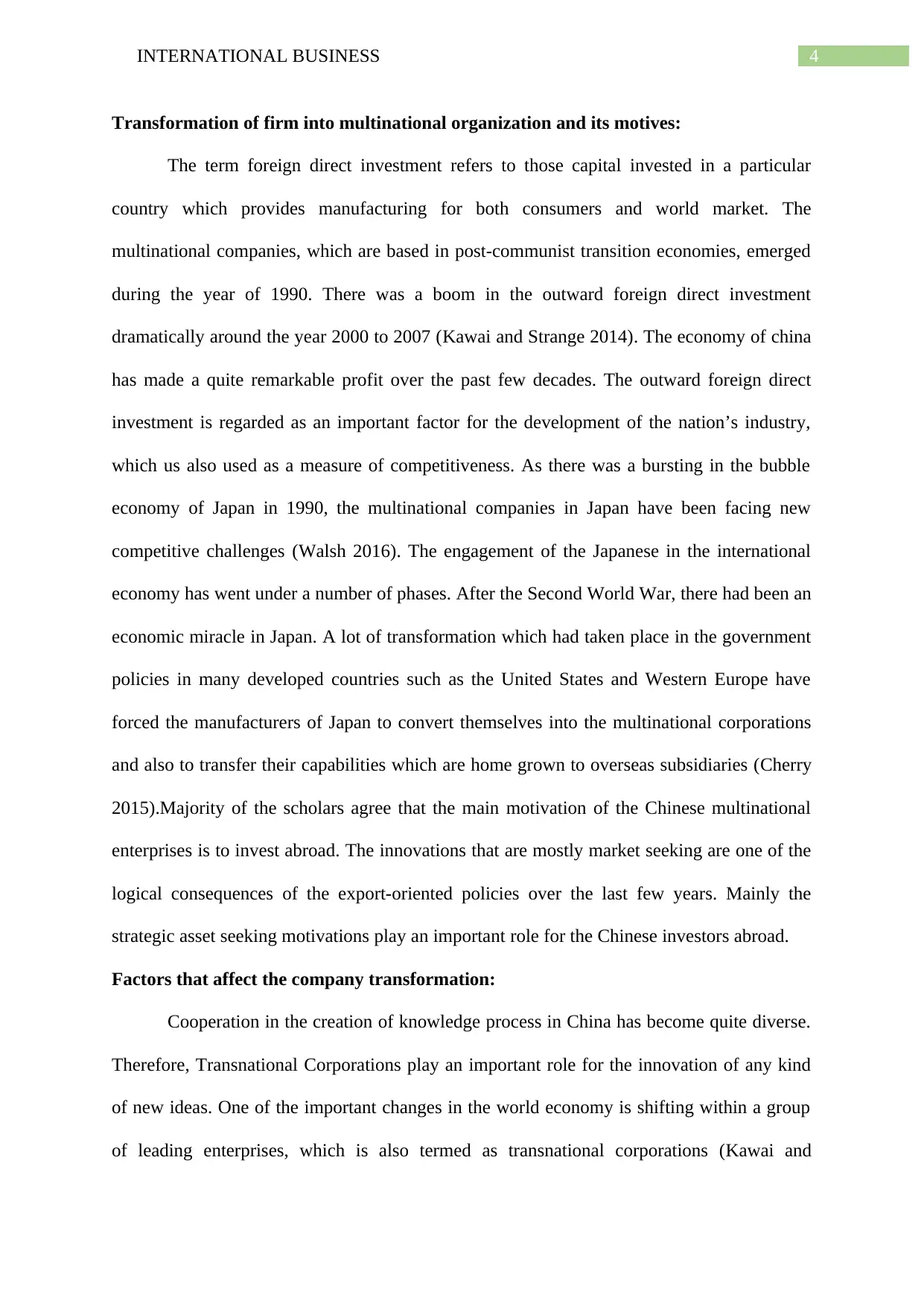
4INTERNATIONAL BUSINESS
Transformation of firm into multinational organization and its motives:
The term foreign direct investment refers to those capital invested in a particular
country which provides manufacturing for both consumers and world market. The
multinational companies, which are based in post-communist transition economies, emerged
during the year of 1990. There was a boom in the outward foreign direct investment
dramatically around the year 2000 to 2007 (Kawai and Strange 2014). The economy of china
has made a quite remarkable profit over the past few decades. The outward foreign direct
investment is regarded as an important factor for the development of the nation’s industry,
which us also used as a measure of competitiveness. As there was a bursting in the bubble
economy of Japan in 1990, the multinational companies in Japan have been facing new
competitive challenges (Walsh 2016). The engagement of the Japanese in the international
economy has went under a number of phases. After the Second World War, there had been an
economic miracle in Japan. A lot of transformation which had taken place in the government
policies in many developed countries such as the United States and Western Europe have
forced the manufacturers of Japan to convert themselves into the multinational corporations
and also to transfer their capabilities which are home grown to overseas subsidiaries (Cherry
2015).Majority of the scholars agree that the main motivation of the Chinese multinational
enterprises is to invest abroad. The innovations that are mostly market seeking are one of the
logical consequences of the export-oriented policies over the last few years. Mainly the
strategic asset seeking motivations play an important role for the Chinese investors abroad.
Factors that affect the company transformation:
Cooperation in the creation of knowledge process in China has become quite diverse.
Therefore, Transnational Corporations play an important role for the innovation of any kind
of new ideas. One of the important changes in the world economy is shifting within a group
of leading enterprises, which is also termed as transnational corporations (Kawai and
Transformation of firm into multinational organization and its motives:
The term foreign direct investment refers to those capital invested in a particular
country which provides manufacturing for both consumers and world market. The
multinational companies, which are based in post-communist transition economies, emerged
during the year of 1990. There was a boom in the outward foreign direct investment
dramatically around the year 2000 to 2007 (Kawai and Strange 2014). The economy of china
has made a quite remarkable profit over the past few decades. The outward foreign direct
investment is regarded as an important factor for the development of the nation’s industry,
which us also used as a measure of competitiveness. As there was a bursting in the bubble
economy of Japan in 1990, the multinational companies in Japan have been facing new
competitive challenges (Walsh 2016). The engagement of the Japanese in the international
economy has went under a number of phases. After the Second World War, there had been an
economic miracle in Japan. A lot of transformation which had taken place in the government
policies in many developed countries such as the United States and Western Europe have
forced the manufacturers of Japan to convert themselves into the multinational corporations
and also to transfer their capabilities which are home grown to overseas subsidiaries (Cherry
2015).Majority of the scholars agree that the main motivation of the Chinese multinational
enterprises is to invest abroad. The innovations that are mostly market seeking are one of the
logical consequences of the export-oriented policies over the last few years. Mainly the
strategic asset seeking motivations play an important role for the Chinese investors abroad.
Factors that affect the company transformation:
Cooperation in the creation of knowledge process in China has become quite diverse.
Therefore, Transnational Corporations play an important role for the innovation of any kind
of new ideas. One of the important changes in the world economy is shifting within a group
of leading enterprises, which is also termed as transnational corporations (Kawai and
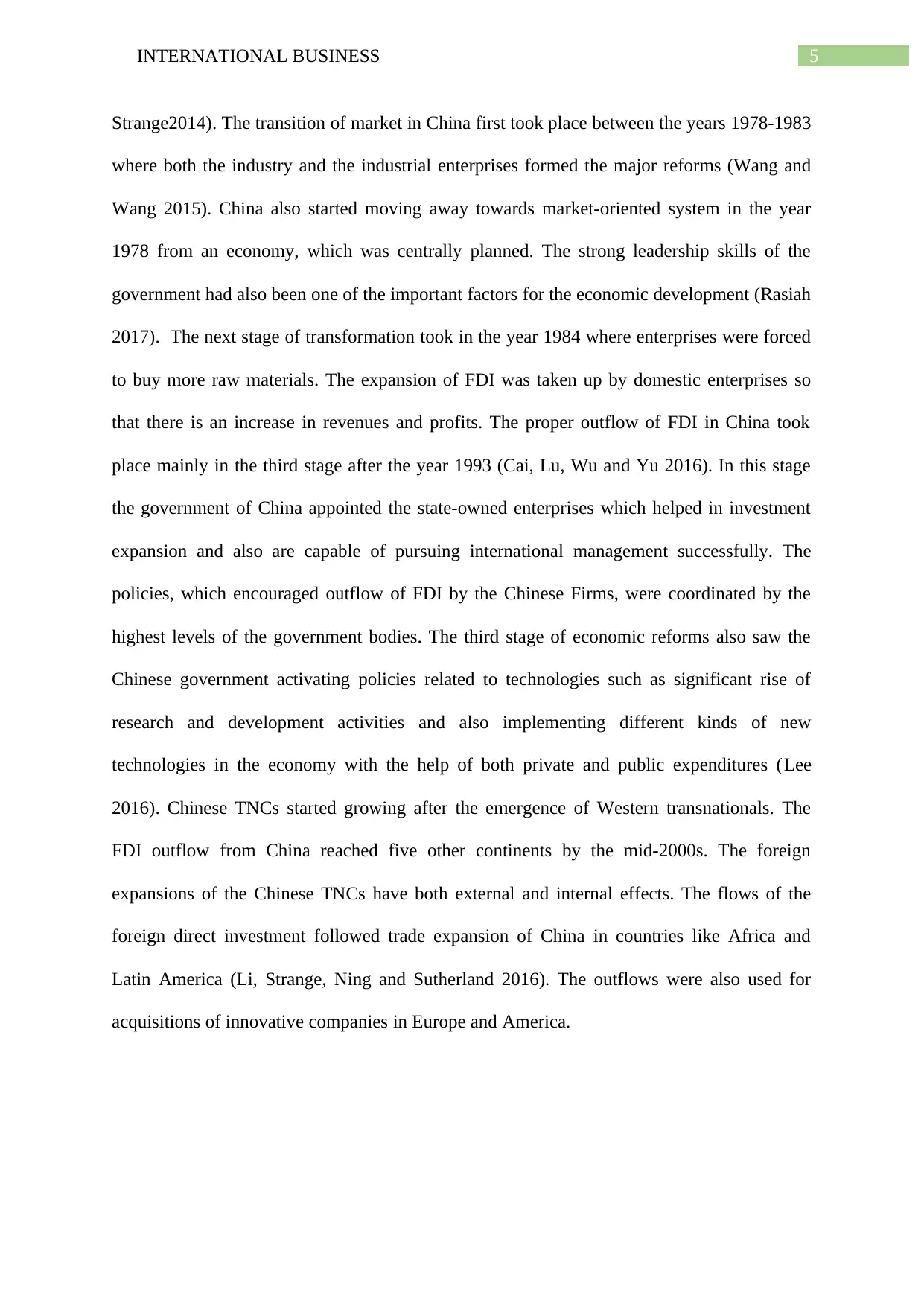
5INTERNATIONAL BUSINESS
Strange2014). The transition of market in China first took place between the years 1978-1983
where both the industry and the industrial enterprises formed the major reforms (Wang and
Wang 2015). China also started moving away towards market-oriented system in the year
1978 from an economy, which was centrally planned. The strong leadership skills of the
government had also been one of the important factors for the economic development (Rasiah
2017). The next stage of transformation took in the year 1984 where enterprises were forced
to buy more raw materials. The expansion of FDI was taken up by domestic enterprises so
that there is an increase in revenues and profits. The proper outflow of FDI in China took
place mainly in the third stage after the year 1993 (Cai, Lu, Wu and Yu 2016). In this stage
the government of China appointed the state-owned enterprises which helped in investment
expansion and also are capable of pursuing international management successfully. The
policies, which encouraged outflow of FDI by the Chinese Firms, were coordinated by the
highest levels of the government bodies. The third stage of economic reforms also saw the
Chinese government activating policies related to technologies such as significant rise of
research and development activities and also implementing different kinds of new
technologies in the economy with the help of both private and public expenditures (Lee
2016). Chinese TNCs started growing after the emergence of Western transnationals. The
FDI outflow from China reached five other continents by the mid-2000s. The foreign
expansions of the Chinese TNCs have both external and internal effects. The flows of the
foreign direct investment followed trade expansion of China in countries like Africa and
Latin America (Li, Strange, Ning and Sutherland 2016). The outflows were also used for
acquisitions of innovative companies in Europe and America.
Strange2014). The transition of market in China first took place between the years 1978-1983
where both the industry and the industrial enterprises formed the major reforms (Wang and
Wang 2015). China also started moving away towards market-oriented system in the year
1978 from an economy, which was centrally planned. The strong leadership skills of the
government had also been one of the important factors for the economic development (Rasiah
2017). The next stage of transformation took in the year 1984 where enterprises were forced
to buy more raw materials. The expansion of FDI was taken up by domestic enterprises so
that there is an increase in revenues and profits. The proper outflow of FDI in China took
place mainly in the third stage after the year 1993 (Cai, Lu, Wu and Yu 2016). In this stage
the government of China appointed the state-owned enterprises which helped in investment
expansion and also are capable of pursuing international management successfully. The
policies, which encouraged outflow of FDI by the Chinese Firms, were coordinated by the
highest levels of the government bodies. The third stage of economic reforms also saw the
Chinese government activating policies related to technologies such as significant rise of
research and development activities and also implementing different kinds of new
technologies in the economy with the help of both private and public expenditures (Lee
2016). Chinese TNCs started growing after the emergence of Western transnationals. The
FDI outflow from China reached five other continents by the mid-2000s. The foreign
expansions of the Chinese TNCs have both external and internal effects. The flows of the
foreign direct investment followed trade expansion of China in countries like Africa and
Latin America (Li, Strange, Ning and Sutherland 2016). The outflows were also used for
acquisitions of innovative companies in Europe and America.
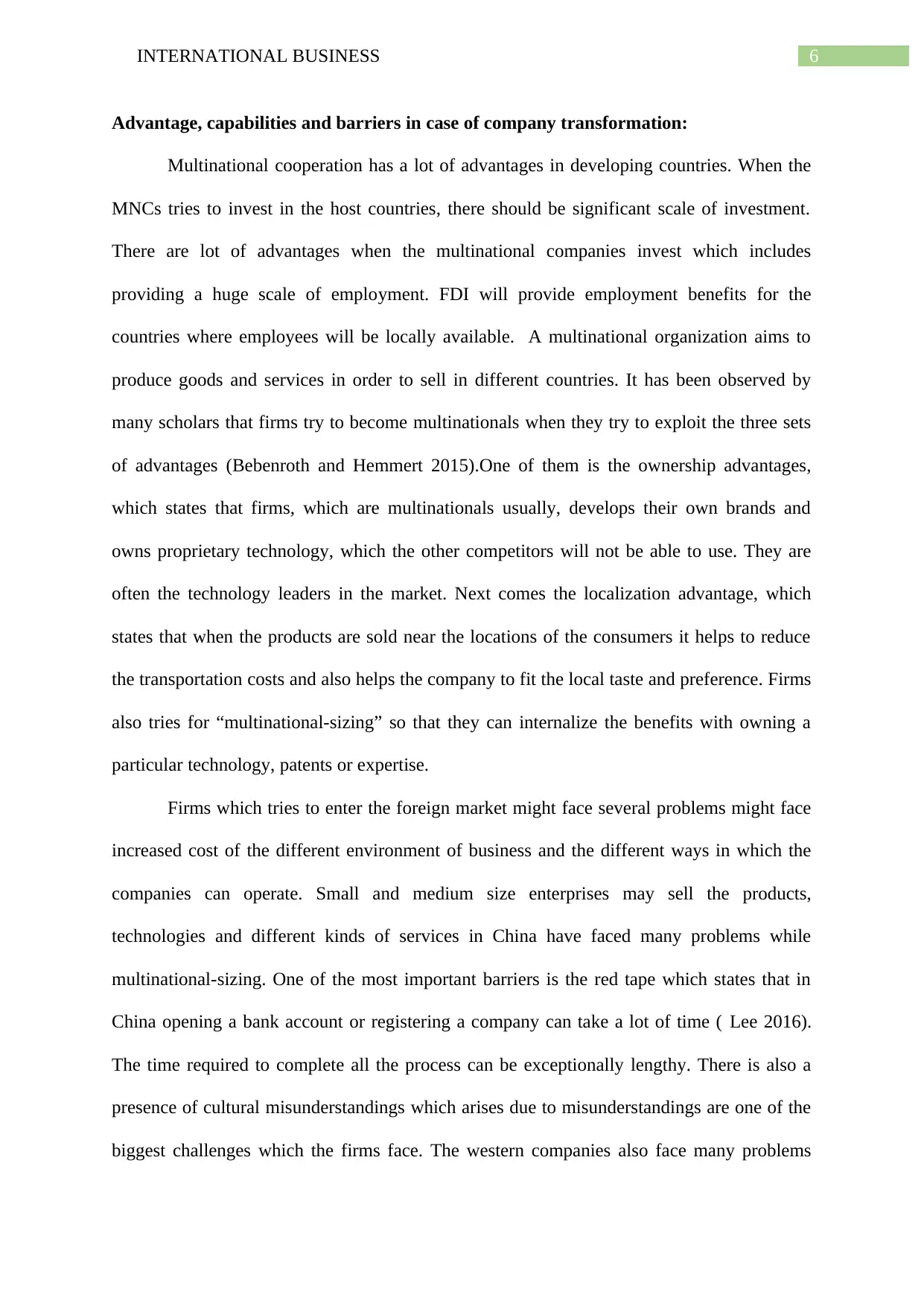
6INTERNATIONAL BUSINESS
Advantage, capabilities and barriers in case of company transformation:
Multinational cooperation has a lot of advantages in developing countries. When the
MNCs tries to invest in the host countries, there should be significant scale of investment.
There are lot of advantages when the multinational companies invest which includes
providing a huge scale of employment. FDI will provide employment benefits for the
countries where employees will be locally available. A multinational organization aims to
produce goods and services in order to sell in different countries. It has been observed by
many scholars that firms try to become multinationals when they try to exploit the three sets
of advantages (Bebenroth and Hemmert 2015).One of them is the ownership advantages,
which states that firms, which are multinationals usually, develops their own brands and
owns proprietary technology, which the other competitors will not be able to use. They are
often the technology leaders in the market. Next comes the localization advantage, which
states that when the products are sold near the locations of the consumers it helps to reduce
the transportation costs and also helps the company to fit the local taste and preference. Firms
also tries for “multinational-sizing” so that they can internalize the benefits with owning a
particular technology, patents or expertise.
Firms which tries to enter the foreign market might face several problems might face
increased cost of the different environment of business and the different ways in which the
companies can operate. Small and medium size enterprises may sell the products,
technologies and different kinds of services in China have faced many problems while
multinational-sizing. One of the most important barriers is the red tape which states that in
China opening a bank account or registering a company can take a lot of time ( Lee 2016).
The time required to complete all the process can be exceptionally lengthy. There is also a
presence of cultural misunderstandings which arises due to misunderstandings are one of the
biggest challenges which the firms face. The western companies also face many problems
Advantage, capabilities and barriers in case of company transformation:
Multinational cooperation has a lot of advantages in developing countries. When the
MNCs tries to invest in the host countries, there should be significant scale of investment.
There are lot of advantages when the multinational companies invest which includes
providing a huge scale of employment. FDI will provide employment benefits for the
countries where employees will be locally available. A multinational organization aims to
produce goods and services in order to sell in different countries. It has been observed by
many scholars that firms try to become multinationals when they try to exploit the three sets
of advantages (Bebenroth and Hemmert 2015).One of them is the ownership advantages,
which states that firms, which are multinationals usually, develops their own brands and
owns proprietary technology, which the other competitors will not be able to use. They are
often the technology leaders in the market. Next comes the localization advantage, which
states that when the products are sold near the locations of the consumers it helps to reduce
the transportation costs and also helps the company to fit the local taste and preference. Firms
also tries for “multinational-sizing” so that they can internalize the benefits with owning a
particular technology, patents or expertise.
Firms which tries to enter the foreign market might face several problems might face
increased cost of the different environment of business and the different ways in which the
companies can operate. Small and medium size enterprises may sell the products,
technologies and different kinds of services in China have faced many problems while
multinational-sizing. One of the most important barriers is the red tape which states that in
China opening a bank account or registering a company can take a lot of time ( Lee 2016).
The time required to complete all the process can be exceptionally lengthy. There is also a
presence of cultural misunderstandings which arises due to misunderstandings are one of the
biggest challenges which the firms face. The western companies also face many problems
Paraphrase This Document
Need a fresh take? Get an instant paraphrase of this document with our AI Paraphraser
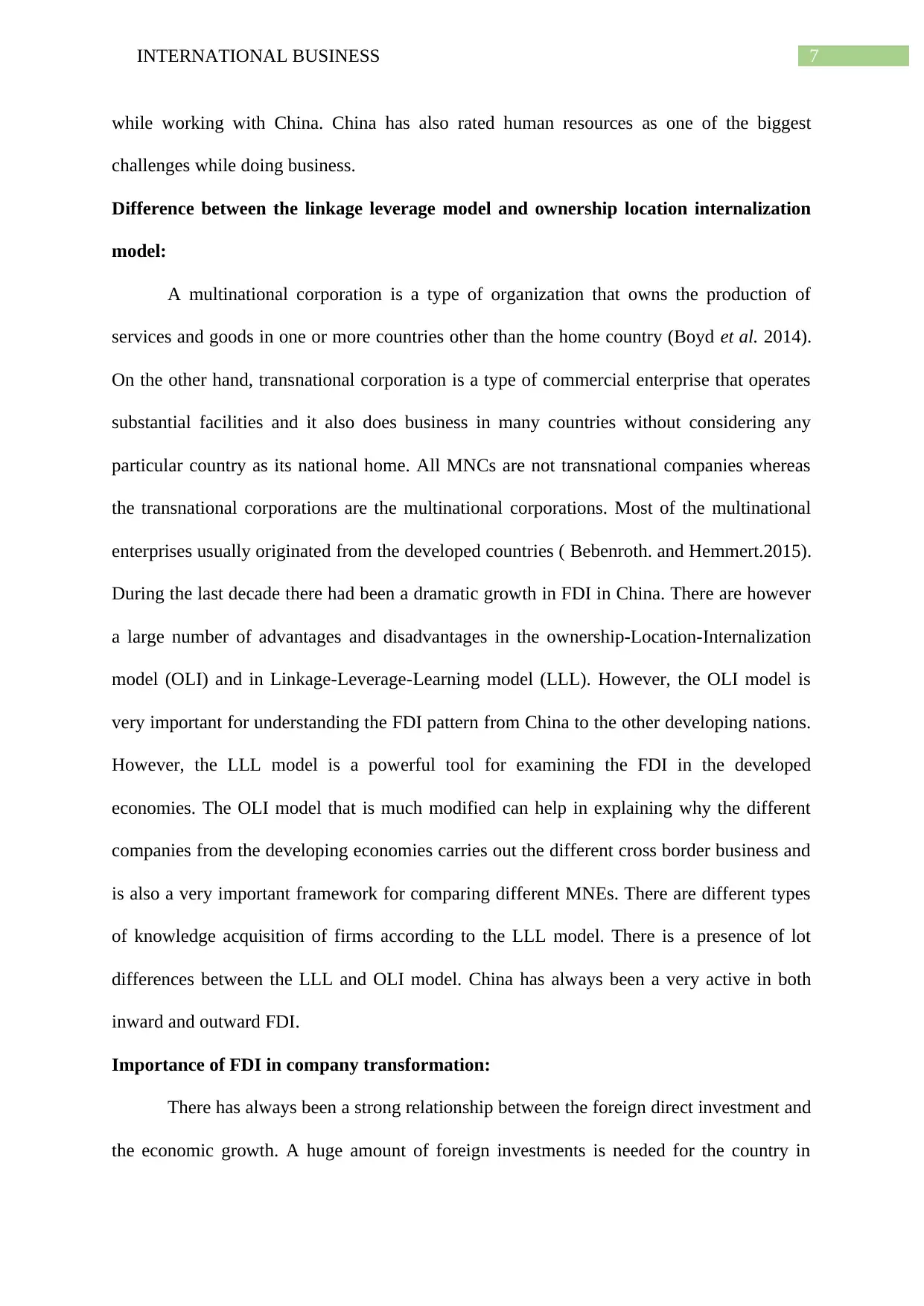
7INTERNATIONAL BUSINESS
while working with China. China has also rated human resources as one of the biggest
challenges while doing business.
Difference between the linkage leverage model and ownership location internalization
model:
A multinational corporation is a type of organization that owns the production of
services and goods in one or more countries other than the home country (Boyd et al. 2014).
On the other hand, transnational corporation is a type of commercial enterprise that operates
substantial facilities and it also does business in many countries without considering any
particular country as its national home. All MNCs are not transnational companies whereas
the transnational corporations are the multinational corporations. Most of the multinational
enterprises usually originated from the developed countries ( Bebenroth. and Hemmert.2015).
During the last decade there had been a dramatic growth in FDI in China. There are however
a large number of advantages and disadvantages in the ownership-Location-Internalization
model (OLI) and in Linkage-Leverage-Learning model (LLL). However, the OLI model is
very important for understanding the FDI pattern from China to the other developing nations.
However, the LLL model is a powerful tool for examining the FDI in the developed
economies. The OLI model that is much modified can help in explaining why the different
companies from the developing economies carries out the different cross border business and
is also a very important framework for comparing different MNEs. There are different types
of knowledge acquisition of firms according to the LLL model. There is a presence of lot
differences between the LLL and OLI model. China has always been a very active in both
inward and outward FDI.
Importance of FDI in company transformation:
There has always been a strong relationship between the foreign direct investment and
the economic growth. A huge amount of foreign investments is needed for the country in
while working with China. China has also rated human resources as one of the biggest
challenges while doing business.
Difference between the linkage leverage model and ownership location internalization
model:
A multinational corporation is a type of organization that owns the production of
services and goods in one or more countries other than the home country (Boyd et al. 2014).
On the other hand, transnational corporation is a type of commercial enterprise that operates
substantial facilities and it also does business in many countries without considering any
particular country as its national home. All MNCs are not transnational companies whereas
the transnational corporations are the multinational corporations. Most of the multinational
enterprises usually originated from the developed countries ( Bebenroth. and Hemmert.2015).
During the last decade there had been a dramatic growth in FDI in China. There are however
a large number of advantages and disadvantages in the ownership-Location-Internalization
model (OLI) and in Linkage-Leverage-Learning model (LLL). However, the OLI model is
very important for understanding the FDI pattern from China to the other developing nations.
However, the LLL model is a powerful tool for examining the FDI in the developed
economies. The OLI model that is much modified can help in explaining why the different
companies from the developing economies carries out the different cross border business and
is also a very important framework for comparing different MNEs. There are different types
of knowledge acquisition of firms according to the LLL model. There is a presence of lot
differences between the LLL and OLI model. China has always been a very active in both
inward and outward FDI.
Importance of FDI in company transformation:
There has always been a strong relationship between the foreign direct investment and
the economic growth. A huge amount of foreign investments is needed for the country in
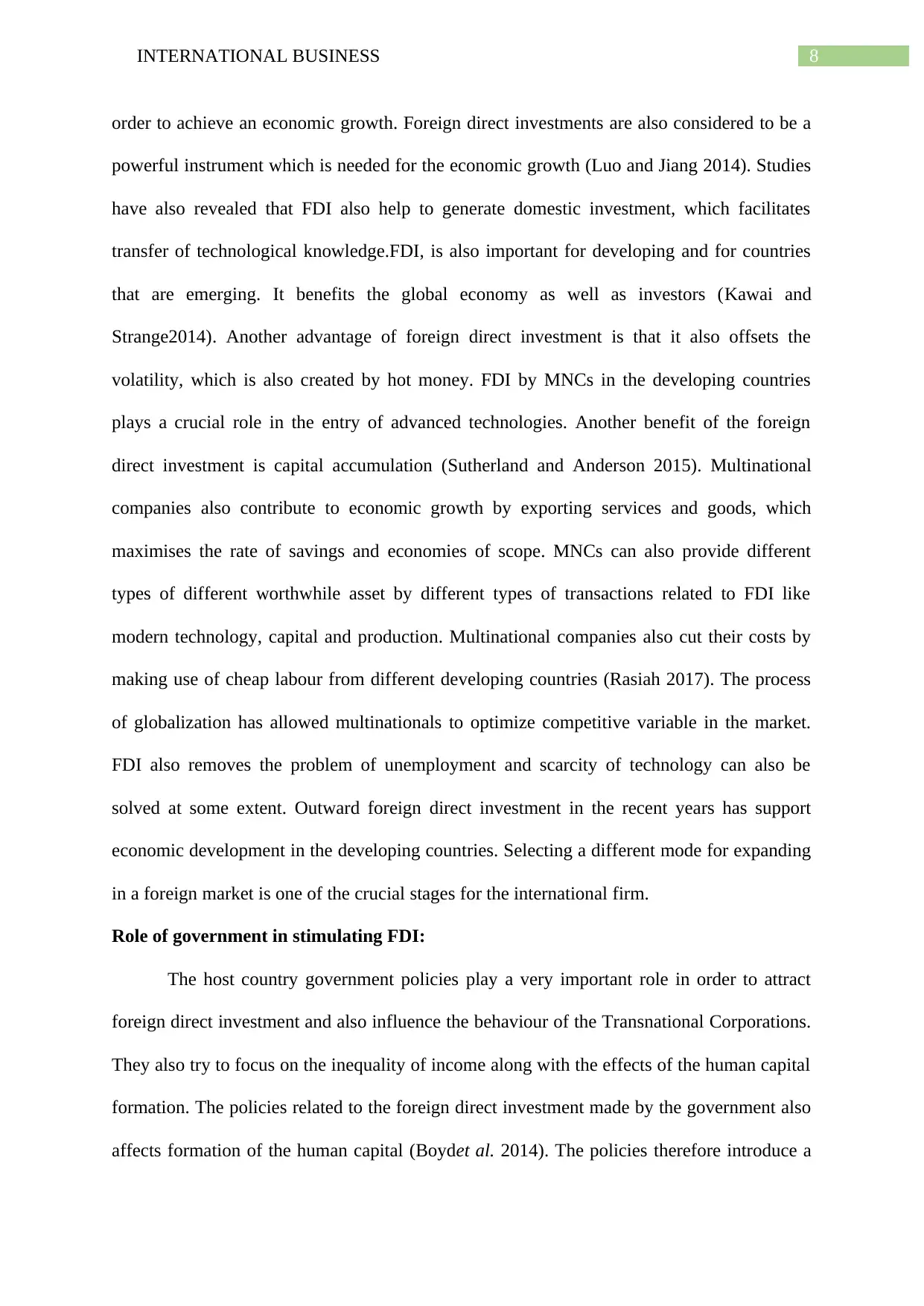
8INTERNATIONAL BUSINESS
order to achieve an economic growth. Foreign direct investments are also considered to be a
powerful instrument which is needed for the economic growth (Luo and Jiang 2014). Studies
have also revealed that FDI also help to generate domestic investment, which facilitates
transfer of technological knowledge.FDI, is also important for developing and for countries
that are emerging. It benefits the global economy as well as investors (Kawai and
Strange2014). Another advantage of foreign direct investment is that it also offsets the
volatility, which is also created by hot money. FDI by MNCs in the developing countries
plays a crucial role in the entry of advanced technologies. Another benefit of the foreign
direct investment is capital accumulation (Sutherland and Anderson 2015). Multinational
companies also contribute to economic growth by exporting services and goods, which
maximises the rate of savings and economies of scope. MNCs can also provide different
types of different worthwhile asset by different types of transactions related to FDI like
modern technology, capital and production. Multinational companies also cut their costs by
making use of cheap labour from different developing countries (Rasiah 2017). The process
of globalization has allowed multinationals to optimize competitive variable in the market.
FDI also removes the problem of unemployment and scarcity of technology can also be
solved at some extent. Outward foreign direct investment in the recent years has support
economic development in the developing countries. Selecting a different mode for expanding
in a foreign market is one of the crucial stages for the international firm.
Role of government in stimulating FDI:
The host country government policies play a very important role in order to attract
foreign direct investment and also influence the behaviour of the Transnational Corporations.
They also try to focus on the inequality of income along with the effects of the human capital
formation. The policies related to the foreign direct investment made by the government also
affects formation of the human capital (Boydet al. 2014). The policies therefore introduce a
order to achieve an economic growth. Foreign direct investments are also considered to be a
powerful instrument which is needed for the economic growth (Luo and Jiang 2014). Studies
have also revealed that FDI also help to generate domestic investment, which facilitates
transfer of technological knowledge.FDI, is also important for developing and for countries
that are emerging. It benefits the global economy as well as investors (Kawai and
Strange2014). Another advantage of foreign direct investment is that it also offsets the
volatility, which is also created by hot money. FDI by MNCs in the developing countries
plays a crucial role in the entry of advanced technologies. Another benefit of the foreign
direct investment is capital accumulation (Sutherland and Anderson 2015). Multinational
companies also contribute to economic growth by exporting services and goods, which
maximises the rate of savings and economies of scope. MNCs can also provide different
types of different worthwhile asset by different types of transactions related to FDI like
modern technology, capital and production. Multinational companies also cut their costs by
making use of cheap labour from different developing countries (Rasiah 2017). The process
of globalization has allowed multinationals to optimize competitive variable in the market.
FDI also removes the problem of unemployment and scarcity of technology can also be
solved at some extent. Outward foreign direct investment in the recent years has support
economic development in the developing countries. Selecting a different mode for expanding
in a foreign market is one of the crucial stages for the international firm.
Role of government in stimulating FDI:
The host country government policies play a very important role in order to attract
foreign direct investment and also influence the behaviour of the Transnational Corporations.
They also try to focus on the inequality of income along with the effects of the human capital
formation. The policies related to the foreign direct investment made by the government also
affects formation of the human capital (Boydet al. 2014). The policies therefore introduce a
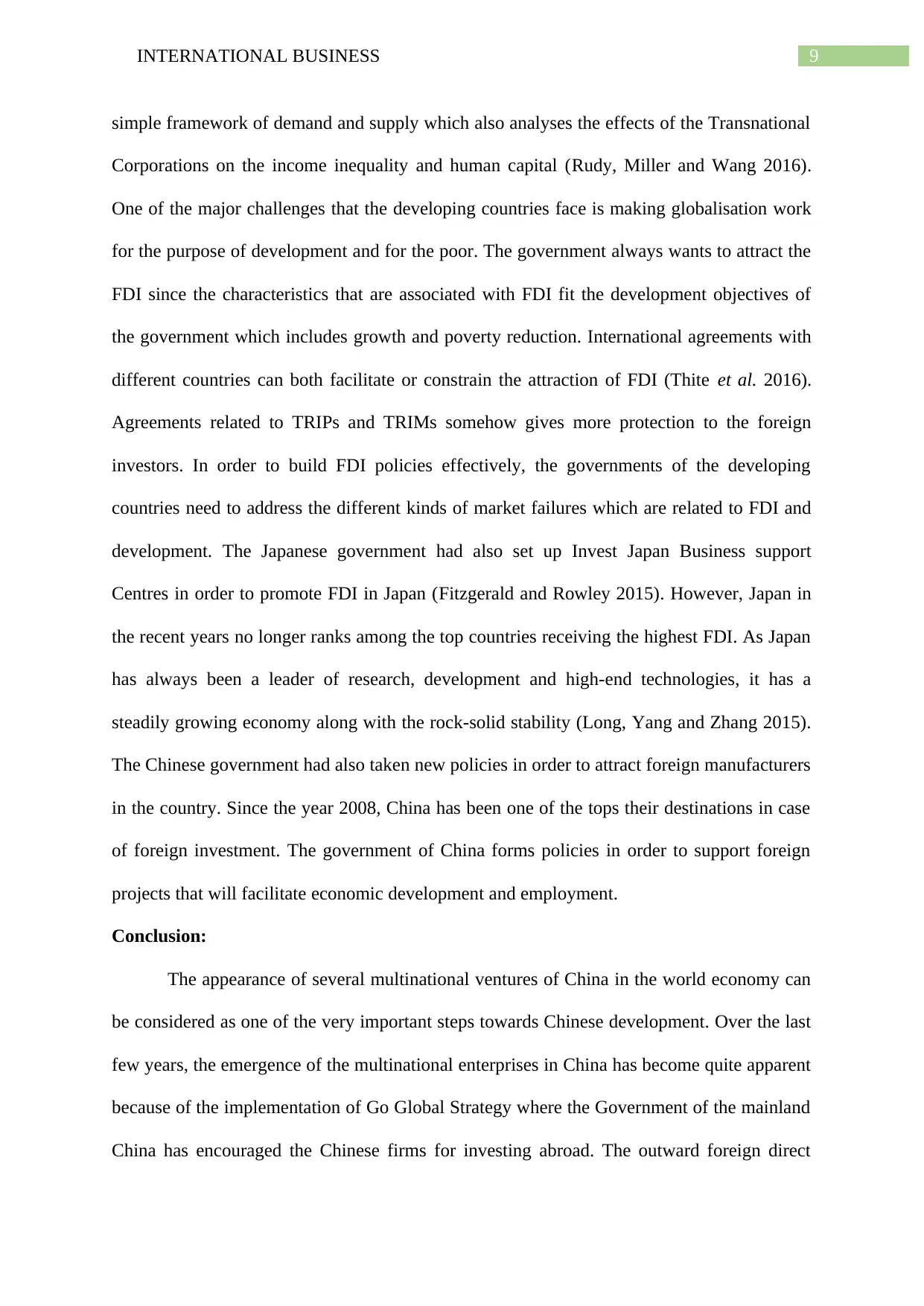
9INTERNATIONAL BUSINESS
simple framework of demand and supply which also analyses the effects of the Transnational
Corporations on the income inequality and human capital (Rudy, Miller and Wang 2016).
One of the major challenges that the developing countries face is making globalisation work
for the purpose of development and for the poor. The government always wants to attract the
FDI since the characteristics that are associated with FDI fit the development objectives of
the government which includes growth and poverty reduction. International agreements with
different countries can both facilitate or constrain the attraction of FDI (Thite et al. 2016).
Agreements related to TRIPs and TRIMs somehow gives more protection to the foreign
investors. In order to build FDI policies effectively, the governments of the developing
countries need to address the different kinds of market failures which are related to FDI and
development. The Japanese government had also set up Invest Japan Business support
Centres in order to promote FDI in Japan (Fitzgerald and Rowley 2015). However, Japan in
the recent years no longer ranks among the top countries receiving the highest FDI. As Japan
has always been a leader of research, development and high-end technologies, it has a
steadily growing economy along with the rock-solid stability (Long, Yang and Zhang 2015).
The Chinese government had also taken new policies in order to attract foreign manufacturers
in the country. Since the year 2008, China has been one of the tops their destinations in case
of foreign investment. The government of China forms policies in order to support foreign
projects that will facilitate economic development and employment.
Conclusion:
The appearance of several multinational ventures of China in the world economy can
be considered as one of the very important steps towards Chinese development. Over the last
few years, the emergence of the multinational enterprises in China has become quite apparent
because of the implementation of Go Global Strategy where the Government of the mainland
China has encouraged the Chinese firms for investing abroad. The outward foreign direct
simple framework of demand and supply which also analyses the effects of the Transnational
Corporations on the income inequality and human capital (Rudy, Miller and Wang 2016).
One of the major challenges that the developing countries face is making globalisation work
for the purpose of development and for the poor. The government always wants to attract the
FDI since the characteristics that are associated with FDI fit the development objectives of
the government which includes growth and poverty reduction. International agreements with
different countries can both facilitate or constrain the attraction of FDI (Thite et al. 2016).
Agreements related to TRIPs and TRIMs somehow gives more protection to the foreign
investors. In order to build FDI policies effectively, the governments of the developing
countries need to address the different kinds of market failures which are related to FDI and
development. The Japanese government had also set up Invest Japan Business support
Centres in order to promote FDI in Japan (Fitzgerald and Rowley 2015). However, Japan in
the recent years no longer ranks among the top countries receiving the highest FDI. As Japan
has always been a leader of research, development and high-end technologies, it has a
steadily growing economy along with the rock-solid stability (Long, Yang and Zhang 2015).
The Chinese government had also taken new policies in order to attract foreign manufacturers
in the country. Since the year 2008, China has been one of the tops their destinations in case
of foreign investment. The government of China forms policies in order to support foreign
projects that will facilitate economic development and employment.
Conclusion:
The appearance of several multinational ventures of China in the world economy can
be considered as one of the very important steps towards Chinese development. Over the last
few years, the emergence of the multinational enterprises in China has become quite apparent
because of the implementation of Go Global Strategy where the Government of the mainland
China has encouraged the Chinese firms for investing abroad. The outward foreign direct
Secure Best Marks with AI Grader
Need help grading? Try our AI Grader for instant feedback on your assignments.
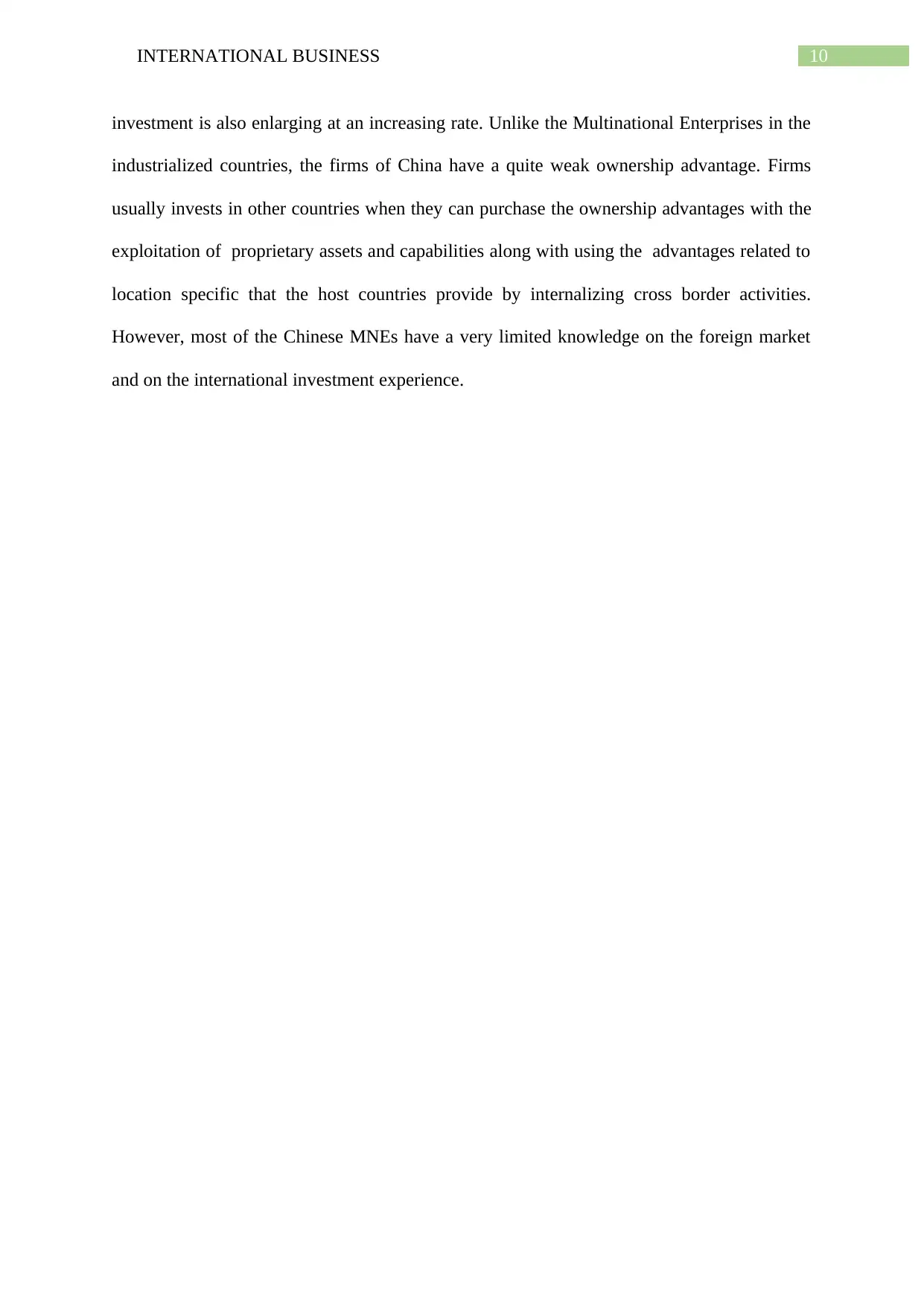
10INTERNATIONAL BUSINESS
investment is also enlarging at an increasing rate. Unlike the Multinational Enterprises in the
industrialized countries, the firms of China have a quite weak ownership advantage. Firms
usually invests in other countries when they can purchase the ownership advantages with the
exploitation of proprietary assets and capabilities along with using the advantages related to
location specific that the host countries provide by internalizing cross border activities.
However, most of the Chinese MNEs have a very limited knowledge on the foreign market
and on the international investment experience.
investment is also enlarging at an increasing rate. Unlike the Multinational Enterprises in the
industrialized countries, the firms of China have a quite weak ownership advantage. Firms
usually invests in other countries when they can purchase the ownership advantages with the
exploitation of proprietary assets and capabilities along with using the advantages related to
location specific that the host countries provide by internalizing cross border activities.
However, most of the Chinese MNEs have a very limited knowledge on the foreign market
and on the international investment experience.

11INTERNATIONAL BUSINESS
Reference:
Bebenroth, R. and Hemmert, M., 2015. Country-level antecedents of target firms’ post-
acquisition business performance: A study of inbound Japanese and Korean M&As. Asian
Business & Management, 14(4), pp.303-325.
Boyd, J.E., Adler, E.P., Otilingam, P.G. and Peters, T., 2014. Internalized Stigma of Mental
Illness (ISMI) scale: a multinational review. Comprehensive Psychiatry, 55(1), pp.221-231.
Cai, X., Lu, Y., Wu, M. and Yu, L., 2016. Does environmental regulation drive away
inbound foreign direct investment? Evidence from a quasi-natural experiment in China.
Journal of Development Economics, 123, pp.73-85.
Cherry, J., 2015. Korean multinationals in Europe. Routledge.
Fan, D., Cui, L., Li, Y. and Zhu, C.J., 2016. Localized learning by emerging multinational
enterprises in developed host countries: A fuzzy-set analysis of Chinese foreign direct
investment in Australia. International Business Review, 25(1), pp.187-203.
Fitzgerald, R. and Rowley, C., 2015. Japanese multinationals in the post-bubble era: new
challenges and evolving capabilities. Asia Pacific Business Review, 21(3), pp.279-294.
Kawai, N. and Strange, R., 2014. Subsidiary autonomy and performance in Japanese
multinationals in Europe. International Business Review, 23(3), pp.504-515.
Lee, L.X.H., 2016. New East Asian Economic Development: The Interaction of Capitalism
and Socialism: The Interaction of Capitalism and Socialism. Routledge.
Li, J., Strange, R., Ning, L. and Sutherland, D., 2016. Outward foreign direct investment and
domestic innovation performance: Evidence from China. International Business Review,
25(5), pp.1010-1019.
Long, C., Yang, J. and Zhang, J., 2015. Institutional impact of foreign direct investment in
China. World Development, 66, pp.31-48.
Reference:
Bebenroth, R. and Hemmert, M., 2015. Country-level antecedents of target firms’ post-
acquisition business performance: A study of inbound Japanese and Korean M&As. Asian
Business & Management, 14(4), pp.303-325.
Boyd, J.E., Adler, E.P., Otilingam, P.G. and Peters, T., 2014. Internalized Stigma of Mental
Illness (ISMI) scale: a multinational review. Comprehensive Psychiatry, 55(1), pp.221-231.
Cai, X., Lu, Y., Wu, M. and Yu, L., 2016. Does environmental regulation drive away
inbound foreign direct investment? Evidence from a quasi-natural experiment in China.
Journal of Development Economics, 123, pp.73-85.
Cherry, J., 2015. Korean multinationals in Europe. Routledge.
Fan, D., Cui, L., Li, Y. and Zhu, C.J., 2016. Localized learning by emerging multinational
enterprises in developed host countries: A fuzzy-set analysis of Chinese foreign direct
investment in Australia. International Business Review, 25(1), pp.187-203.
Fitzgerald, R. and Rowley, C., 2015. Japanese multinationals in the post-bubble era: new
challenges and evolving capabilities. Asia Pacific Business Review, 21(3), pp.279-294.
Kawai, N. and Strange, R., 2014. Subsidiary autonomy and performance in Japanese
multinationals in Europe. International Business Review, 23(3), pp.504-515.
Lee, L.X.H., 2016. New East Asian Economic Development: The Interaction of Capitalism
and Socialism: The Interaction of Capitalism and Socialism. Routledge.
Li, J., Strange, R., Ning, L. and Sutherland, D., 2016. Outward foreign direct investment and
domestic innovation performance: Evidence from China. International Business Review,
25(5), pp.1010-1019.
Long, C., Yang, J. and Zhang, J., 2015. Institutional impact of foreign direct investment in
China. World Development, 66, pp.31-48.

12INTERNATIONAL BUSINESS
Luo, Y. and Jiang, H., 2014. Effective public relations leadership in organizational change: A
study of multinationals in mainland China. Journal of Public Relations Research, 26(2),
pp.134-160.
Rasiah, R., 2017. The role of institutions and linkages in learning and innovation. Institutions
and Economies, pp.165-172.
Rudy, B.C., Miller, S.R. and Wang, D., 2016. Revisiting FDI strategies and the flow of firm‐
specific advantages: A focus on state‐owned enterprises. Global Strategy Journal, 6(1),
pp.69-78.
Rugman, A.M., Nguyen, Q.T. and Wei, Z., 2016. Rethinking the literature on the
performance of Chinese multinational enterprises. Management and Organization Review,
12(2), pp.269-302.
Sutherland, D. and Anderson, J., 2015. The pitfalls of using foreign direct investment data to
measure Chinese multinational enterprise activity. The China Quarterly, 221, pp.21-48.
Thite, M., Wilkinson, A., Budhwar, P. and Mathews, J.A., 2016. Internationalization of
emerging Indian multinationals: Linkage, leverage and learning (LLL) perspective.
International Business Review, 25(1), pp.435-443.
Walsh, K.A., 2016. China R&D: a high-tech field of dreams. In SEEKING CHANGES: The
Economic Development in Contemporary China (pp. 191-212).
Wang, J. and Wang, X., 2015. Benefits of foreign ownership: Evidence from foreign direct
investment in China. Journal of International Economics, 97(2), pp.325-338.
Wang, K.C.A., Wang, Y.J. and Liang, W.J., 2016. How Does International Licensing Affect
FDI?. Academia Economic Papers, 44(3), p.361.
Luo, Y. and Jiang, H., 2014. Effective public relations leadership in organizational change: A
study of multinationals in mainland China. Journal of Public Relations Research, 26(2),
pp.134-160.
Rasiah, R., 2017. The role of institutions and linkages in learning and innovation. Institutions
and Economies, pp.165-172.
Rudy, B.C., Miller, S.R. and Wang, D., 2016. Revisiting FDI strategies and the flow of firm‐
specific advantages: A focus on state‐owned enterprises. Global Strategy Journal, 6(1),
pp.69-78.
Rugman, A.M., Nguyen, Q.T. and Wei, Z., 2016. Rethinking the literature on the
performance of Chinese multinational enterprises. Management and Organization Review,
12(2), pp.269-302.
Sutherland, D. and Anderson, J., 2015. The pitfalls of using foreign direct investment data to
measure Chinese multinational enterprise activity. The China Quarterly, 221, pp.21-48.
Thite, M., Wilkinson, A., Budhwar, P. and Mathews, J.A., 2016. Internationalization of
emerging Indian multinationals: Linkage, leverage and learning (LLL) perspective.
International Business Review, 25(1), pp.435-443.
Walsh, K.A., 2016. China R&D: a high-tech field of dreams. In SEEKING CHANGES: The
Economic Development in Contemporary China (pp. 191-212).
Wang, J. and Wang, X., 2015. Benefits of foreign ownership: Evidence from foreign direct
investment in China. Journal of International Economics, 97(2), pp.325-338.
Wang, K.C.A., Wang, Y.J. and Liang, W.J., 2016. How Does International Licensing Affect
FDI?. Academia Economic Papers, 44(3), p.361.
1 out of 13
Related Documents
Your All-in-One AI-Powered Toolkit for Academic Success.
+13062052269
info@desklib.com
Available 24*7 on WhatsApp / Email
![[object Object]](/_next/static/media/star-bottom.7253800d.svg)
Unlock your academic potential
© 2024 | Zucol Services PVT LTD | All rights reserved.





